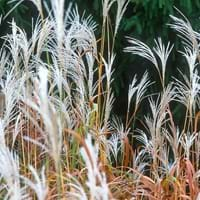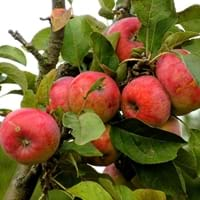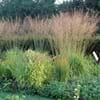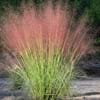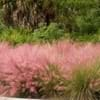Life Span
Perennial
Perennial
Origin
Africa, Southern Asia
Eastern Europe, Southern Europe, Russia/Siberia, Southern Asia, Western Asia
Types
Not Available
Not Available
Number of Varieties
Not Available
Habitat
Floodplains, meadows, Riverbanks
Hillside, Mountain Slopes, Temperate Regions
USDA Hardiness Zone
4-9
3-8
Sunset Zone
Not Available
4, 5, 6, 7, 15, 16
Habit
Clump-Forming
Oval or Rounded
Flower Color
Not Available
White
Flower Color Modifier
Bicolor
Bicolor
Fruit Color
Not Available
Red, Purple, Dark Red
Leaf Color in Spring
Dark Green
Green
Leaf Color in Summer
Light Green
Green
Leaf Color in Fall
Orange, Light Yellow, Gold, Brown, Bronze
Green, Light Yellow, Brown
Leaf Color in Winter
Orange, Light Yellow, Gold, Brown, Bronze
Light Green
Leaf Shape
Long Linear
Oblong
Plant Season
Summer, Fall
Spring, Fall
Sunlight
Full Sun, Partial Sun
Full Sun, Partial Sun, Partial shade
Growth Rate
Medium
Medium
Type of Soil
Loam
Clay, Loam, Sand
The pH of Soil
Acidic, Neutral
Acidic, Neutral
Soil Drainage
Average
Well drained
Bloom Time
Late Spring, Early Summer, Summer, Late Summer, Early Fall
Early Spring, Spring
Tolerances
Drought
Drought
Where to Plant?
Container, Ground, Pot
Ground
How to Plant?
Divison, Seedlings
Grafting, Seedlings, Transplanting
Plant Maintenance
Medium
Medium
Watering Requirements
Requires regular watering
Medium
In Summer
Lots of watering
Lots of watering
In Spring
Moderate
Moderate
In Winter
Average Water
Average Water
Soil pH
Acidic, Neutral
Acidic, Neutral
Soil Type
Loam
Clay, Loam, Sand
Soil Drainage Capacity
Average
Well drained
Sun Exposure
Full Sun, Partial Sun
Full Sun, Partial Sun, Partial shade
Pruning
Remove dead or diseased plant parts
Remove damaged leaves, Remove dead branches, Remove dead leaves
Fertilizers
All-Purpose Liquid Fertilizer
All-Purpose Liquid Fertilizer
Pests and Diseases
Not Available
Black rot, Leaf spot, Scab
Plant Tolerance
Drought
Drought
Flowers
Not Available
Showy
Flower Petal Number
Single
Single
Foliage Texture
Medium
Medium
Foliage Sheen
Matte
Matte
Attracts
Not Available
Not Available
Allergy
Asthma
Mouth itching, Throat itching
Aesthetic Uses
Showy Purposes
Not Used For Aesthetic Purpose
Beauty Benefits
Not Available
Not Available
Environmental Uses
Air purification
Air purification
Medicinal Uses
No Medicinal Use
Cancer, constipation, Diabetes, Diarrhea, Dysentry, Fever, Heart problems, Tooth ache
Part of Plant Used
Whole plant
Fruits
Other Uses
Used as Ornamental plant
Used As Food, Wood is used for making furniture
Used As Indoor Plant
Insignificant
No
Used As Outdoor Plant
Yes
Yes
Garden Design
Container, Hedges, Mixed Border, Screening / Wind Break
Edible, Feature Plant, Fruit / Fruit Tree, Topiary / Bonsai / Espalier
Botanical Name
MISCANTHUS sacchariflorus
Malus domestica Spartan
Common Name
Amur Silvergrass
Spartan Apple
In Hindi
Amur Silvergrass
Spartan Apple
In German
Amur Schilf
Spartan Apple
In French
Amur silvergrass
Spartan Apple
In Spanish
Amur silvergrass
Spartan Apple
In Greek
Amur Silvergrass
Spartan Apple
In Portuguese
Amur Silvergrass
Spartan Apple
In Polish
Amur Silvergrass
Spartan Apple
In Latin
Amur Silvergrass
Spartan Apple
Phylum
Magnoliophyta
Magnoliophyta
Class
Liliopsida
Magnoliopsida
Clade
Angiosperms, Commelinids, Monocots
Angiosperms, Eudicots, Rosids
Tribe
Not Available
Not Available
Subfamily
Panicoideae
Not Available
Number of Species
Not Available
Properties of Amur Silvergrass and Spartan Apple
Wondering what are the properties of Amur Silvergrass and Spartan Apple? We provide you with everything About Amur Silvergrass and Spartan Apple. Amur Silvergrass doesn't have thorns and Spartan Apple doesn't have thorns. Also Amur Silvergrass does not have fragrant flowers. Amur Silvergrass has allergic reactions like Asthma and Spartan Apple has allergic reactions like Asthma. Compare all the properties and characteristics of these two plants. Find out which of these plant can be used as indoor plant. If you are interested to decorate your house and garden, find out aesthetic uses, compare them and select the plant which will beautify your surrounding. Along with beautification, try comparing medicinal and edible uses of Amur Silvergrass and Spartan Apple and you can choose the plant having best and most benefits.
Season and Care of Amur Silvergrass and Spartan Apple
Season and care of Amur Silvergrass and Spartan Apple is important to know. While considering everything about Amur Silvergrass and Spartan Apple Care, growing season is an essential factor. Amur Silvergrass season is Summer and Fall and Spartan Apple season is Summer and Fall. The type of soil for Amur Silvergrass is Loam and for Spartan Apple is Clay, Loam, Sand while the PH of soil for Amur Silvergrass is Acidic, Neutral and for Spartan Apple is Acidic, Neutral.
Amur Silvergrass and Spartan Apple Physical Information
Amur Silvergrass and Spartan Apple physical information is very important for comparison. Amur Silvergrass height is 90.00 cm and width 90.00 cm whereas Spartan Apple height is 370.00 cm and width 460.00 cm. The color specification of Amur Silvergrass and Spartan Apple are as follows:
Amur Silvergrass flower color: Not Available
Amur Silvergrass leaf color: Dark Green
Spartan Apple flower color: White
- Spartan Apple leaf color: Green
Care of Amur Silvergrass and Spartan Apple
Care of Amur Silvergrass and Spartan Apple include pruning, fertilizers, watering etc. Amur Silvergrass pruning is done Remove dead or diseased plant parts and Spartan Apple pruning is done Remove damaged leaves, Remove dead branches and Remove dead leaves. In summer Amur Silvergrass needs Lots of watering and in winter, it needs Average Water. Whereas, in summer Spartan Apple needs Lots of watering and in winter, it needs Average Water.
